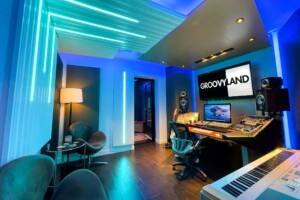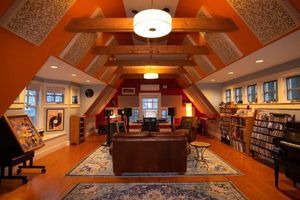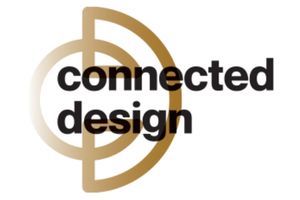
Groovyland Studios · North Miami Beach, USA
As a result of the pandemic, the definition of home and its main functions have changed forever. What once was just an occasional work-from-home desk is now a full-time office space; basements have been converted into school rooms and gyms, or sometimes both. The idea of having multi-purpose and flexible spaces has grown and evolved over the last few years, culminating in a completely new space: the e-studio.
At the forefront of this trend is Walters-Storyk Design Group (WSDG), an international company known for designing lavish recording studios for legends like Jimmy Hendrix and Whitney Houston. Once the pandemic started, they found themselves bringing their acoustical and technical knowledge to smaller residential spaces that they transformed into the exemplary work and collaboration spaces. They coined the term “e-studio” to define this trend, as they continue to find more clients looking for this type of space in their own home.
Finding a Niche Need
According to partner and director of business development Sergio Molho, the e-studio concept is a charming way to describe this mission-control style room meant for anything from distance learning and teaching to making remote speeches and directing a company. “It’s amazing the vast locations, ages and profiles looking for this,” said Molho. “From teachers to CEOs, people need excellent audio and visuals to work effectively.” Content creation seems to be a standard need across the board for these clients. Younger generations are recording podcasts and Youtube videos at home; celebrity artists are doing more recordings in their own personal studios. Now it is also very possible — and often more practical — for content collaborations to take place remotely, but this also means that the network, acoustics and video need to be above and beyond. However the biggest issue with these spaces is that the rooms clients need them in are getting smaller and smaller. There is also a common interest in lower frequencies, particularly for musicians, which is difficult to enhance in a smaller room. That’s where WSDG found their musical and acoustical knowledge helpful. “We started using low frequency analysis (LFA) in our design process,” said John Storyk, founding partner and director of design at WSDG, who added that they started a completely separate software that does this analysis exclusively. This NIRO software analyzes the geometry of a space — sending it through an algorithm hundreds of times until it settles the optimum geometry — and advises the team how to move and implement acoustical panels. “The software is for any environment where critical listening happens,” said Storyk.

Abbott Road Studio · Boston, USA
Don’t Skimp on the Vibe
The e-studio is not turning out to be a purely pragmatic space. When clients call in looking for one, they also are asking for a specific feel that will make working in the e-studio more creative and fun.
“Convincing people that these rooms should be cool is easy now,” said Joshua Morris, partner and COO of WSDG, explaining that they have a technical interior design team on staff. “There has to be an experience factor now.”
The design of these small e-studios is incredibly detailed and immersive. Depending on the use, the team uses LED indirect and dimple lighting, and if there is a strong video conference situation, they also work to get rid of unsightly shadows. The furniture layout is thought through, sometimes allowing for collaborative spaces or simply comfortable pieces for creative thinking. Along with the strategically placed acoustical panels, the architecture is also critiqued and enhanced with details like slotted wood, metal structures and more.
“The last year and a half has taught clients that it doesn’t matter where you are, you just need a good connection and a reasonable room to work and create,” said Storyk. “We predict that these rooms will continue to get smaller, and the threshold of entry for these spaces will get less as more people live, work and collaborate remotely.”









